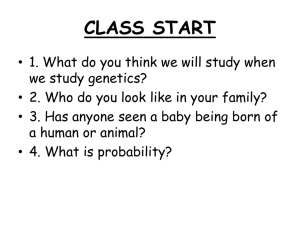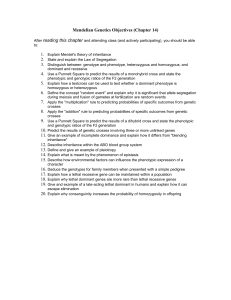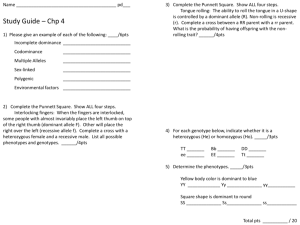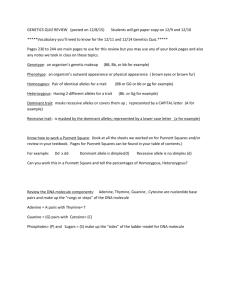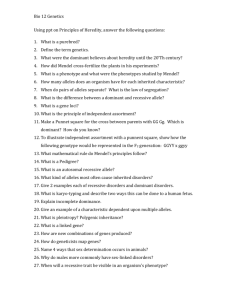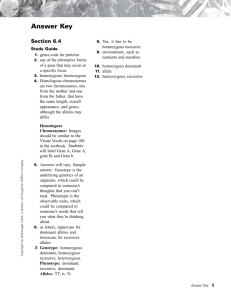punnett squares, monohybrid, dyhibrid and sex
advertisement
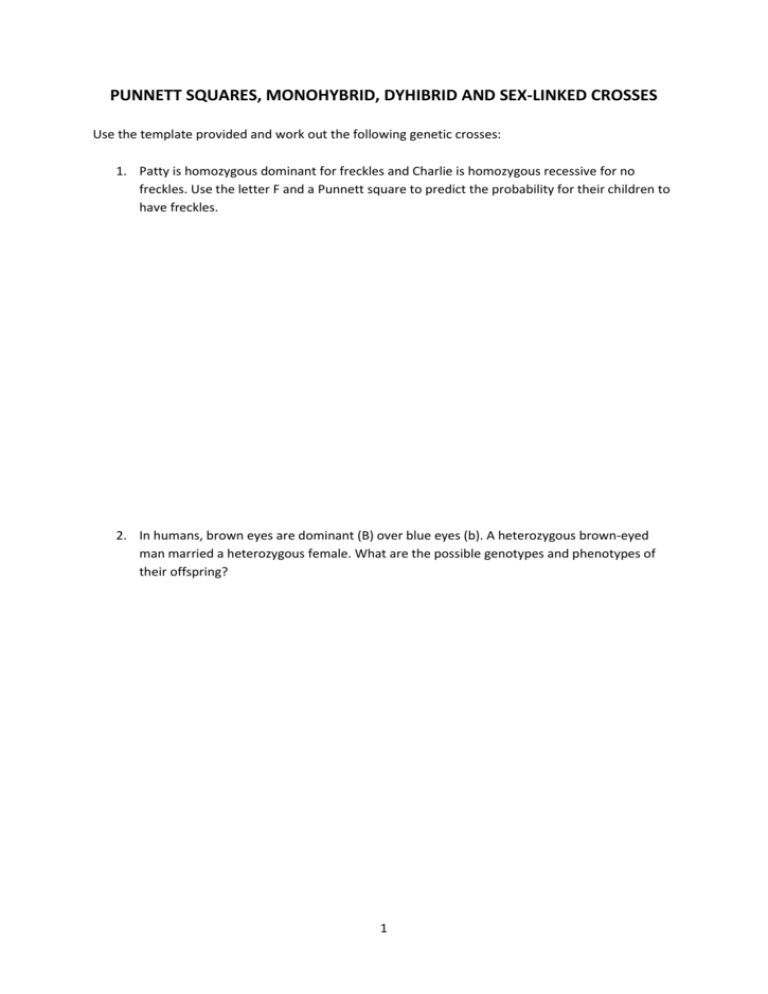
PUNNETT SQUARES, MONOHYBRID, DYHIBRID AND SEX-LINKED CROSSES Use the template provided and work out the following genetic crosses: 1. Patty is homozygous dominant for freckles and Charlie is homozygous recessive for no freckles. Use the letter F and a Punnett square to predict the probability for their children to have freckles. 2. In humans, brown eyes are dominant (B) over blue eyes (b). A heterozygous brown-eyed man married a heterozygous female. What are the possible genotypes and phenotypes of their offspring? 1 3. Cystic fibrosis is a recessive genetic disorder. Ron is homozygous dominant (FF) and Natalie is a carrier of cystic fibrosis. Us a Punnett square to predict the possibility that one of their children will have cystic fibrosis. 4. Larry and Lola Little have achondroplasia, a form of dwarfism. Both are heterozygous. Their son, Big Bob, is 2 metres tall. Use the letters A and a and a Punnett square to show how Bob got his genotype and phenotype. 2 5. Woody Guthrie, author of This is Your Land was heterozygous for Huntington’s disease (Hh). His wife was homozygous recessive and perfectly normal (hh). Huntington’s disease is caused by a latent dominant gene, meaning that it is not phenotypically expressed until late in life. Dominant disease genes are expressed in homozygous dominant and heterozygous people. Draw a Punnett diagram for Woody and his wife and predict the chances of their possible children to have Huntington’s. 6. The normal female condition is the result of a chromosomal pairing XX, while the normal male condition is XY. Certain genes, not affecting female characteristics in any way, are located on the X chromosome and cause sex-linked recessive traits. As a result females must have two recessive alleles to exhibit any particular characteristic associated with one of these genes, while males need only receive one allele. The reason for the male anomaly is that the Y chromosome does not carry versions of the same genes as the X chromosome. Consequently, only females can be true heterozygotes. Haemophilia is a rare hereditary human disease of the blood. The blood of individuals with this disease does not clot properly; even a small cut can be lethal. In a marriage of two nonhaemophiliac parents a bleeder son is born. Use a Punnett square to calculate the possibilities of their sons being born bleeders, daughters being born bleeders or carriers. Use the following combinations: XHY for a normal, healthy male XhY for bleeder male H H X X for normal, healthy female XHXh for carrier female 3 7. In humans colour blindness (b) is an example of a sex-linked recessive trait. A male with colour blindness marries a female who is not colour blind, but carries the (b) allele. Use a Punnett diagram and determine the genotypic and phenotypic possibilities for their offspring. 8. Dihybrid crosses use Punnett squares to distribute parental alleles from two genes into gametes as would be predicted by meiosis. Guidelines for dihybrid Punnett squares Pair alleles in the following way: e.g. AaBb – gametes are: AB Ab aB ab Dominant alleles are written before recessive alleles (as for monohybrids) EXCEPT for distributing alleles in dihybrid crosses. Alleles of the same gene always stay together. In garden peas tallness (T) is dominant to shortness (t) and axillary flowers (A) are dominant to terminal flowers (a). What are the expected ratios for the genotypes and phenotypes of the offspring if a heterozygous tall, heterozygous axillary plant is crossed with a heterozygous tall, terminal plant? 4 9. Imagine that a couple is planning to have children. They have Huntington’s disease as well as Tay-Sachs in their families and go for genetic testing and counselling. The male is heterozygous for Huntington’s disease and homozygous dominant for Tay-Sachs. The female is homozygous recessive for Huntington’s and heterozygous for Tay-Sachs. Huntington’s disease is dominant (H) over the “normal” condition (h) and in Tay-Sachs the “normal” condition is dominant (T) over Tay-Sachs (t). What will the counsellor tell them about their chances to have children with Huntington’s disease and/or Tay-Sachs? 5 10. Explain how you would rule in the following paternity case: Charlotte and Clive have been in a relationship for five months when she told him that she was pregnant. Clive immediately accused her of sleeping with his friend Peter and refused to take any responsibility for Charlotte or her baby. Charlotte denied being unfaithful and Peter said he wanted nothing to do with her either. When the baby was born Charlotte turned to the courts for support and a blood test as well as a DNA test was ordered. Both men were subpoenaed to give specimens for testing. While they were still waiting for the DNA results, the blood test revealed the following: The baby was blood group O and Charlotte blood group A. Clive tested as being from blood group B and Peter was AB. Which of the men could be the baby’s father? Illustrate your answer by means of the appropriate genetic crosses. 6

